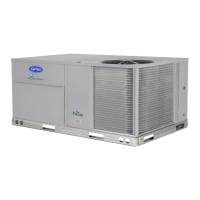3
ACOUSTICAL CONSIDERATIONS
In order to minimize sound transmitted to the space, please con-
form to the following recommendations (see Fig. 1):
Location
• Avoid locating the unit above sound-sensitive areas. In-
stead, locate the unit above restrooms, storage areas, corri-
dors, or other noise-tolerant areas.
• Avoid mounting the unit in the middle of large roof ex-
panses between vertical supports. This will minimize the
phenomenon known as roof bounce.
• Install the units close to vertical roof supports (columns or
load bearing walls).
• Locate the units at least 25 feet away from critical areas. If
this is not possible, the ductwork and ceiling structure
should be acoustically treated.
• Consider the use of vibration isolators or an acoustic curb.
Ductwork
• Utilize flexible connectors between the unit and the supply
and return ducts.
• Supply and return air main trunk ducts should be located
over hallways and/or public areas.
• Provide trailing edge turning vanes in ductwork elbows
and tees to reduce air turbulence.
• Make the ductwork as stiff as possible.
• Use round duct wherever possible because it is less noisy.
• Seal all penetrations around ductwork entering the space.
• Make sure that ceiling and wall contractors do not attach
hangers or supports to ductwork.
• Provide as smooth and gradual transition as possible when
connecting the rooftop unit discharge to the supply duct.
• If a ceiling plenum return is utilized, provide a return el-
bow or tee to eliminate line-of-sight noise to the space.
Face the entrance of the return duct away from other adja-
cent units.
Acoustic Insulation
• Provide acoustic interior lining for first 20 feet of supply
and return duct or until the first elbow is encountered. The
elbow prevents line-of-sight transmission in the supply
and return ducts.
• Install a double layer of 2-in. low density quilted fiberglass
acoustical pad with a
1
/
8
-in. barium-loaded vinyl facing on
top of the roof deck before building insulation and roofing
installation occur. Place the material inside the curb and
for 4 to 8 ft beyond the unit perimeter, dependent upon unit
size (larger units require a wider apron outside the curb).
Openings in the pad should only be large enough for the
supply and return ducts. An alternate approach is to use
two layers of gypsum board with staggered seams in addi-
tion to the acoustical pad.
AVERTISSEMENT
RISQUE D’INTOXICATION AU MONOXYDE DE
CARBONE
Si ces directives ne sont pas suivies, cela peut entraîner des
blessures graves ou une intoxication au monoxyde de carbone
pouvant causer la mort, si des produits de combustion s’infil-
trent dans le bâtiment.
Vérifier que toutes les ouvertures pratiquées dans le mur ex-
térieur autour du ou des tuyaux d’évent (et de la prise d’air)
sont scellées de manière à empêcher l’infiltration de produits
de combustion dans le bâtiment.
Veiller à ce que la ou les sorties de l’évent de l’appareil de
chauffage (et la prise d’air) ne soient, en aucune façon, ob-
struées, quelle que soit la saison.
WARNING
FIRE HAZARD
Failure to follow this warning could result in severe personal
injury and/or property damage.
Inlet pressure tap set screw must be tightened and
1
/
8
-in. NPT
pipe plug must be installed to prevent gas leaks.
WARNING
FIRE HAZARD
Failure to follow this warning could result in severe personal
injury and/or property damage.
Manifold pressure tap set screw must be tightened and
1
/
8
-in.
NPT pipe plug must be installed to prevent gas leaks.
CAUTION
DO NOT re-use compressor oil or any oil that has been ex-
posed to the atmosphere. Dispose of oil per local codes and
regulations. DO NOT leave refrigerant system open to air any
longer than the actual time required to service the equipment.
Seal circuits being serviced and charge with dry nitrogen to
prevent oil contamination when timely repairs cannot be com-
pleted. Failure to follow these procedures may result in dam-
age to equipment.
GAS VALVE
INLET PRESSURE
TAP SET SCREW
MANIFOLD
GAS VALVE
MANIFOLD PRESSURE
TAP SET SCREW

